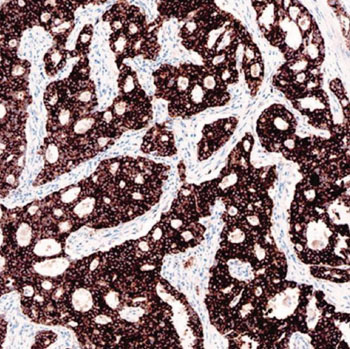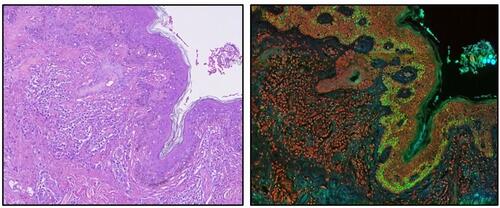Anaplastic Lymphoma Kinase Immunohistochemistry Compares with FISH Testing
By LabMedica International staff writers
Posted on 06 Nov 2014
The detection of anaplastic lymphoma kinase (ALK)-gene rearrangements in non–small-cell lung cancer (NSCLC) is mainly performed by fluorescence in situ hybridization (FISH).Posted on 06 Nov 2014
Testing positive for ALK is required in order to be prescribed the therapeutic inhibitors, however, the FISH test is expensive, time-consuming, and requires specialized equipment and expertise. A semi-quantitative ALK protein expression test, using immunohistochemistry (IHC) is available.

Image: Immunohistochemistry of lung tissue positive for anaplastic lymphoma kinase in non-small-cell lung cancer (Photo courtesy of Ventana Medical Systems).
An international team of scientists at 16 institutes of pathology across Europe who are members of the International Association for the Study of Lung Cancer (Aurora, CO, USA) tested and scored for IHC 15 well-characterized NSCLC specimens. The specimens were pre-tested three times by FISH at two separate institutions in Germany. Prior to the IHC testing all the equipment was standardized between all the institutions and the scoring pathologists all attended an internet-based training session with teaching cases.
Each laboratory utilized the VENTANA ALK-D5F3 IHC (Ventana Medical Systems; Oro Valley, AZ, USA) assay. All seven ALK FISH-negative cases were homogenously scored as ALK-IHC negative. All 16 participating institutes scored the two ALK positive-“borderline” samples as unequivocally positive according to their protein expression. Concordant IHC interpretation was also noticed in four of six unequivocal ALK break positive cases. In two of six samples, some observers described a weak/heterogeneous ALK-IHC staining. These two cases were confirmed ALK positive by a third test, a reverse transcription-polymerase chain reaction (RT-PCR). The last two cases were ALK-FISH positive and were scored IHC positive by 15/16 and 12/16 institutions, respectively. However, those not scoring these two cases as unequivocal ALK IHC positive called them IHC equivocal and would have demanded an additional ALK test (FISH, PCR) under diagnostic conditions.
The authors concluded that this so-called “ALK-Harmonization-Study” showed for the first time that predictive semiquantitative IHC reveals reliable and reproducible results across several laboratories when methodology and interpretation are strictly defined and the pathologists are uniquely trained. The application of validated ALK IHC assays and its comparison to ALK-FISH is highly needed in future clinical trials. This might answer the question if ALK-IHC cannot only serve as a prescreening tool, but as a stand-alone test at least in cases displaying an unequivocally staining pattern as well as an alternative predictive test in samples with reduced FISH interpretability. The study was published in the November 2014 issue of the Journal of Thoracic Oncology.
Related Links:
International Association for the Study of Lung Cancer
Ventana Medical Systems













